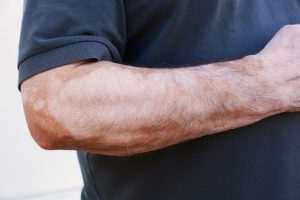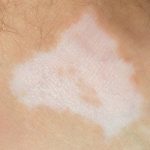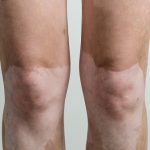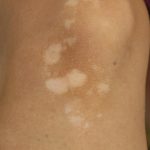 June 25th is World Vitiligo Day. It is a global event whose purpose is to raise awareness of vitiligo—a skin disorder in which white patches of skin appear on different parts of the body. Sadly, those affected by this condition are subjected to bullying, social neglect, and psychological trauma due to their odd appearance. We at Bel Marra sympathize with this and want to do our part to educate people about this harmless disorder. Here you will find detailed information about the condition as well as recommendations for a vitiligo diet. This skin disorder is complex, and many other conditions are possibly related to it. To better familiarize yourself, we have rounded up related topics touching on insulin resistance, thyroid disease risk, and dry eye syndrome.
June 25th is World Vitiligo Day. It is a global event whose purpose is to raise awareness of vitiligo—a skin disorder in which white patches of skin appear on different parts of the body. Sadly, those affected by this condition are subjected to bullying, social neglect, and psychological trauma due to their odd appearance. We at Bel Marra sympathize with this and want to do our part to educate people about this harmless disorder. Here you will find detailed information about the condition as well as recommendations for a vitiligo diet. This skin disorder is complex, and many other conditions are possibly related to it. To better familiarize yourself, we have rounded up related topics touching on insulin resistance, thyroid disease risk, and dry eye syndrome.
Vitiligo diet chart: Foods to eat and avoid
Vitiligo is a skin condition where the pigment of the skin is lost in certain areas, making the skin appear white. Although a vitiligo-specific diet isn’t supported by too much scientific data, skin specialists still recommend a vitiligo diet in order to boost the immune system, as vitiligo is an autoimmune disease and a strong immune system can prevent the spread of the disease.
Advertisement
Some key points to a vitiligo diet include boosting the immune system with foods rich in phytochemicals, beta carotene, and antioxidants to slow down disease progression; avoiding foods that contain hydroquinones, which have depigmentation properties; avoiding citrus fruits and turmeric as they can result in additional skin problems; and avoiding red meat and dairy, especially if you have an allergy, as they can negatively impact your vitiligo. Continue reading…
 Can a gluten-free diet cure vitiligo?
Can a gluten-free diet cure vitiligo?
Can a gluten-free diet cure vitiligo? Well, we know that a gluten-free diet is recommended for those who suffer from celiac disease as they have intolerance to gluten. Both celiac disease and vitiligo are autoimmune diseases, and in vitiligo, the skin pigment is lost causing lighter patches. In cases where the two conditions occur together, there is evidence that sticking to a gluten-free diet not only aids in celiac disease but can help with vitiligo, too.
While the effects of vitiligo are not life-threatening, the skin condition can have psychological and social implications depending on where the pigment is lost on the body. Vitiligo affects roughly one percent of the population, and although it is not contagious, vitiligo patients feel somewhat stigmatized. Continue reading…
 Vitiligo and the increased risk of insulin resistance
Vitiligo and the increased risk of insulin resistance
Vitiligo is associated with an increased risk of insulin resistance. Vitiligo is a disorder that results in discolored patches on the skin, hair, and mucus membrane. Roughly one to two percent of the population has vitiligo, and it is believed to be caused by genetic and environmental factors.
Insulin resistance is not only a risk factor for diabetes, but it can raise one’s risk of cardiovascular disease as well. Insulin resistance is when the body produces insulin but does not know how to properly use it. As a result, the insulin can enter the bloodstream, raising blood glucose levels and causing damage. Continue reading…
 Vitiligo may increase thyroid disease risk, new vitiligo treatment may help
Vitiligo may increase thyroid disease risk, new vitiligo treatment may help
Vitiligo may increase thyroid disease risk and a new vitiligo treatment may help improve the skin discoloration caused by the disorder. Results from a systematic review and meta-analysis found that thyroid disease is a common comorbidity in vitiligo patients. The authors noted that, “thyroid disease has been suggested to be associated with vitiligo… the outcomes of prevalence studies on thyroid disease in vitiligo vary widely.”
The researchers carried out a literature review and selected over 48 studies, which included 24,000 vitiligo patients. Of the selected studies, 33 reported thyroid disease prevalence among patients, 19 reported autoimmune thyroid disease, and 38 reported thyroid antibodies. Continue reading…
 Vitiligo patients face dry eye syndrome, other eye health risks
Vitiligo patients face dry eye syndrome, other eye health risks
Advertisement
Vitiligo patients face dry eye syndrome along with other eye health risks. Significant differences were seen in vitiligo patients who underwent the Schirmer test, which determines if the eye produces enough tears for proper moisture.
The study looked at 61 vitiligo patients and 57 control individuals. The patients and controls underwent several eye tests, including the Schirmer test.
The researchers found that the average Schirmer score for vitiligo patients was 6.74 ± 9.11 mm and 17.64 ± 9.41 mm for the right and left eye, respectively, compared with 21.96 ± 12.51 mm and 23.42 ± 12.51 mm for the right and left eye, respectively, in the control group individuals. Continue reading…
